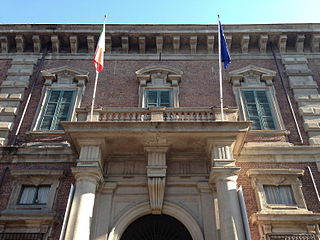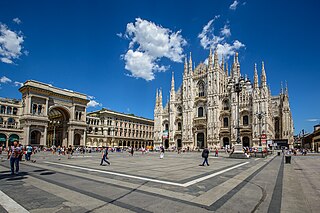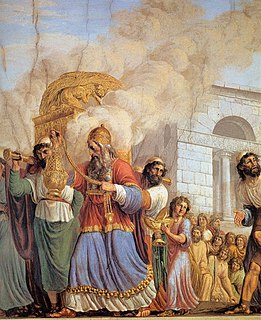Other uses
- Brera Calcio, a football club based in Milan
Brera may refer to:

The University of Milan, known colloquially as UniMi or Statale, is a public research university in Milan, Italy. It is one of the largest universities in Europe, with about 60,000 students, and a permanent teaching and research staff of about 2,000.

Benvenuto Tisi was a Late-Renaissance-Mannerist Italian painter of the School of Ferrara. Garofalo's career began attached to the court of the Duke d'Este. His early works have been described as "idyllic", but they often conform to the elaborate conceits favored by the artistically refined Ferrarese court. His nickname, Garofalo, may derive from his habit of signing some works with a picture of a carnation.

Merate is a municipality of 14,872 inhabitants in the province of Lecco, in the northern Italian region of Lombardy. It is served by Cernusco-Merate railway station.

Giovanni Luigi "Gianni" Brera was an Italian sports journalist and novelist. This is a description by himself: "My real name is Giovanni Luigi Brera. I was born on 8 September 1919 in San Zenone Po in the province of Pavia, and grew up like a wild man among woods, river banks and still waters. [...] I am a Padan from the banks and flood plains, the bush and the sandbanks. I soon realized I was a legitimate son of the Po".

The Brera Observatory is an astronomical observatory in the Brera district of Milan, Italy. It was built in the historic Palazzo Brera in 1764 by the Jesuit astronomer Roger Boscovich. Following the suppression of the Jesuits by Clement XIV on 21 July 1773, the palace and the observatory passed to the then rulers of northern Italy, the Austrian Habsburg dynasty. Following the independence of Italy in 1861, the observatory has been run by the Italian government.

The Pinacoteca di Brera is the main public gallery for paintings in Milan, Italy. It contains one of the foremost collections of Italian paintings, an outgrowth of the cultural program of the Brera Academy, which shares the site in the Palazzo Brera.

Palazzo Brera or Palazzo di Brera is a monumental palace in Milan, in Lombardy in northern Italy. It was a Jesuit college for two hundred years. It now houses several cultural institutions including the Accademia di Brera, the art academy of the city, and its gallery, the Pinacoteca di Brera; the Orto Botanico di Brera, a botanical garden; an observatory, the Osservatorio Astronomico di Brera; the Istituto Lombardo Accademia di Scienze e Lettere, a learned society; and an important library, the Biblioteca di Brera.

Arena Civica, officially Arena Gianni Brera, is a multi-purpose stadium in Milan, Italy, which was opened on 18 August 1807. One of the city's main examples of neoclassical architecture, today it mainly hosts football and rugby union games, concerts and cultural events. The stadium can hold 18,000–30,000 spectators.

The Accademia di Belle Arti di Brera, also known as the Accademia di Brera or Brera Academy, is a state-run tertiary public academy of fine arts in Milan, Italy. It shares its history, and its main building, with the Pinacoteca di Brera, Milan's main public museum for art. In 2010 an agreement was signed to move the accademia to a former military barracks, the Caserma Magenta in via Mascheroni, but the move had not happened by early 2017.

The Orto Botanico di Brera is a botanical garden located behind Palazzo Brera at Via Brera 28 in the center of Milan, Lombardy, Italy, and operated by the Istituto di Fisica Generale Applicata of the University of Milan. It is open weekdays without charge.
The Nicola Trussardi Foundation is a non-profit institution for the promotion of contemporary art and culture. Created in 1996, the Nicola Trussardi Foundation ran its own exhibiting space in Piazza della Scala in Milan.

Brera is a district ("quartiere") of Milan, Italy. It is located within the Zone 1 and it is centered on Via Brera. The name stems from Medieval Italian "braida" or "brera", derived from Old Lombardic "brayda", meaning a land expanse either cleared of trees or naturally lacking them. This is because around the year 900, the Brera district was situated just outside Milan's city walls and was kept clear for military reasons. The root of the word is the same as that of the Dutch city of Breda's name and the English word "broad".

The Zone 1 of Milan, since 2016 officially Municipality 1 of Milan, is one of the 9 administrative administrative divisions of Milan, Italy.
The following is a timeline of the history of the city of Milan, Italy.

Neoclassical architecture in Milan encompasses the main artistic movement from about 1750 to 1850 in this northern Italian city. From the final years of the reign of Maria Theresa of Austria, through the Napoleonic Kingdom of Italy and the European Restoration, Milan was in the forefront of a strong cultural and economic renaissance in which Neoclassicism was the dominant style, creating in Milan some of the most influential works in this style in Italy and across Europe. Notable developments include construction of the Teatro alla Scala, the restyled Royal Palace, and the Brera institutions including the Academy of Fine Arts, the Braidense Library and the Brera Astronomical Observatory. Neoclassicism also led to the development of monumental city gates, new squares and boulevards as well as public gardens and private mansions. Latterly two churches, San Tomaso in Terramara and San Carlo al Corso, were completed in Neoclassical style before the period came to an end in the late 1830s.

The Biblioteca Nazionale Braidense or Braidense National Library, usually known as the Biblioteca di Brera, is a public library in Milan, in northern Italy. It is one of the largest libraries in Italy. Initially it contained large historical and scientific collections before it was charged with the legal deposit of all publications from Milan. Since 1880, it has had the status of a national library and is today one of the 47 Italian State libraries.

Luigi Ademollo was an Italian painter.

Luciano Caramel is an Italian art critic, curator and art historian. In the 1980s he was Deputy Director of the Accademia di Belle Arti di Brera in Milan. He taught contemporary art at the Università Cattolica del Sacro Cuore in Milan and at Accademia Albertina in Turin. He is an expert on the work of Medardo Rosso. His publications include Arte in Italia 1945-1960, a university textbook.

Santa Maria in Brera was a church in Milan, in Lombardy in northern Italy. It was built by the Humiliati between 1180 and 1229, given a marble façade and Gothic portal by Giovanni di Balduccio in the fourteenth century, and deconsecrated and partly demolished under Napoleonic rule in the early nineteenth century. The Napoleonic rooms of the Pinacoteca di Brera occupy the upper floor of what was the nave.

The following outline is provided as an overview of and topical guide to Milan: